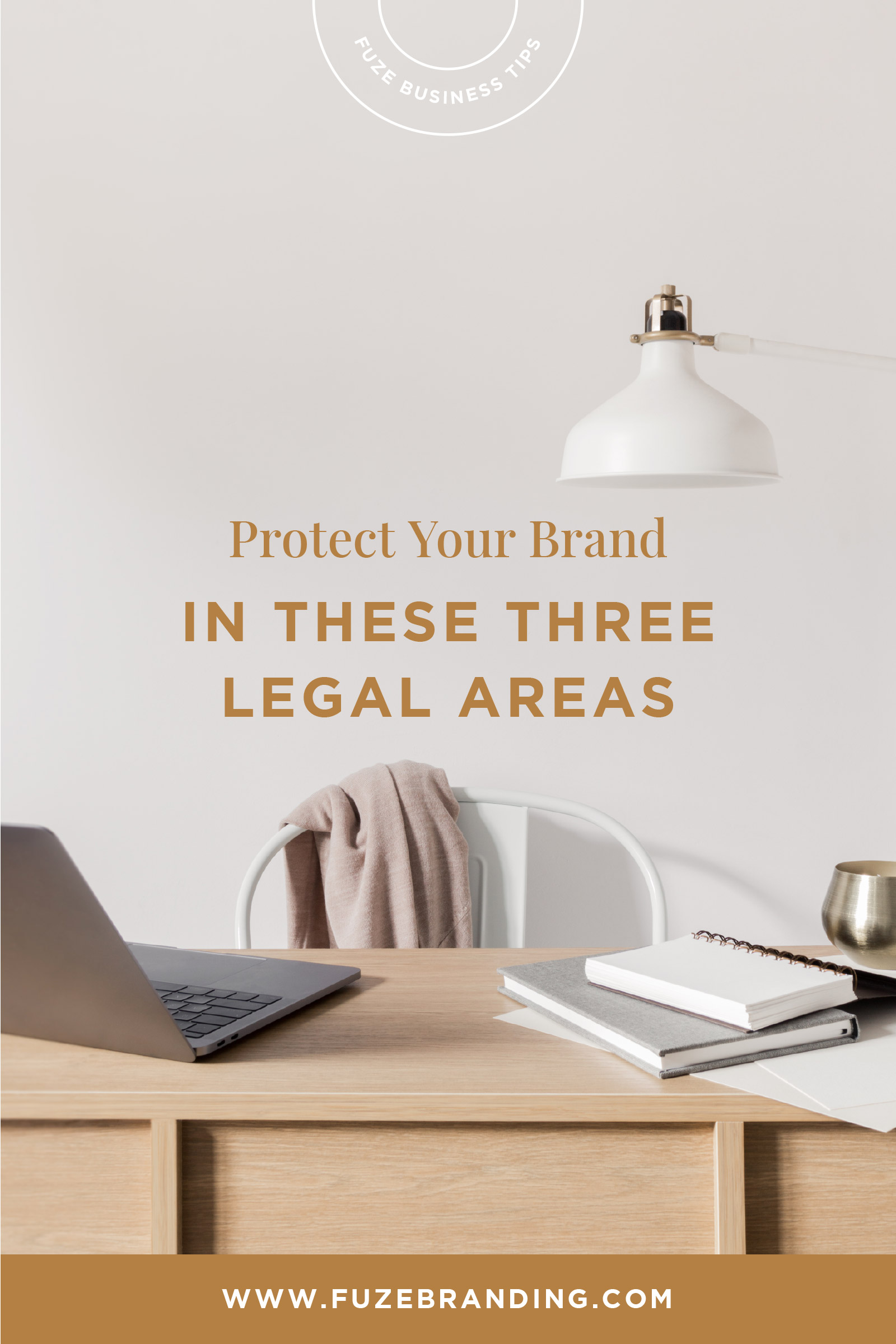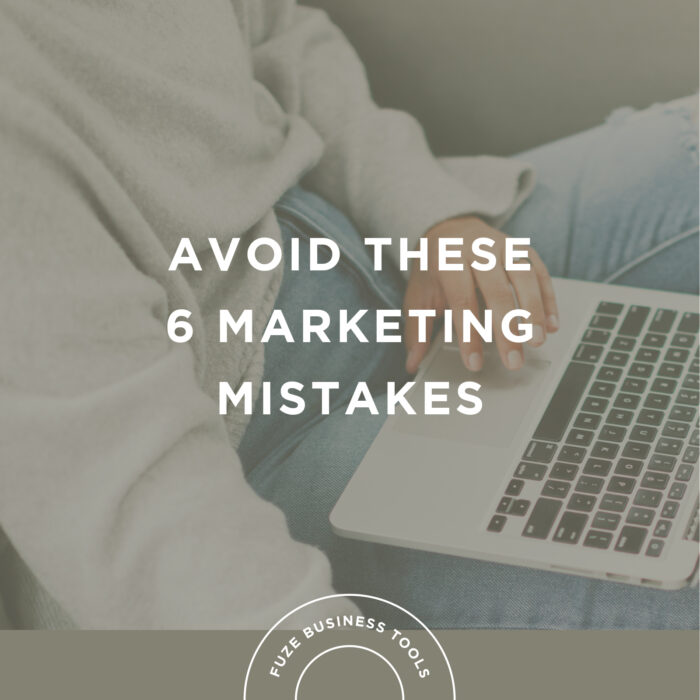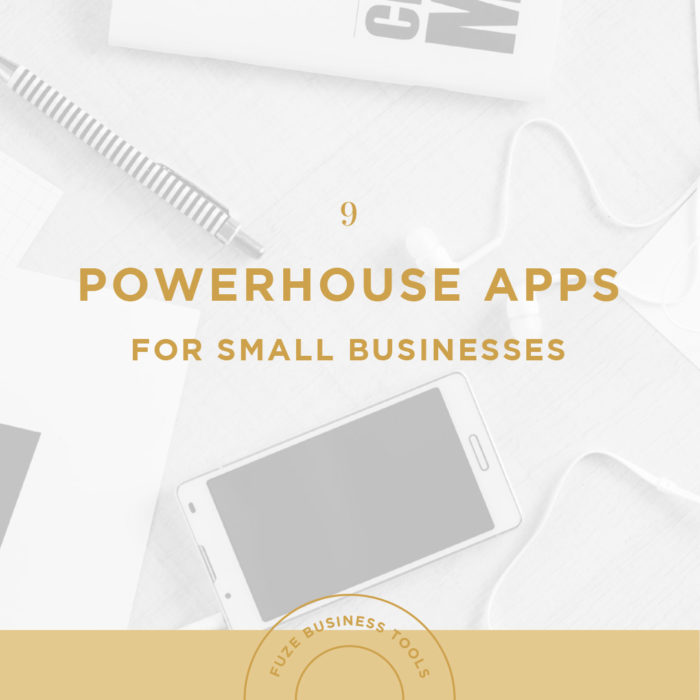Small Business Tips
Protect Your Brand in These Three Legal Areas
You’ve got the perfect name. The logo is on point. The branding elements are coming together nicely, telling the story of your company in an authentic and engaging way.
But is it going to get you sued?
When you’re dealing with branding, you’re dealing with complex issues like trademark, copyright, and licensing, and it’s vitally important to the future of your business to know you’re standing on solid ground when it comes to the legalities of branding.
We’re going to break down a few concepts that can be confusing and also give you some particular areas where you need to do your due diligence when it comes to your new company name or visual brand identity.
1) Trademarking your company name
According to the US Patent & Trademark Office (USPTO), the authority which oversees the registration of trademarks and patents within our country, “A trademark is a word, phrase, symbol, and/or design that identifies and distinguishes the source of the goods of one party from those of others.” By registering your trademark with the USPTO, you publicly declare your intent to operate your business under that mark. You’ll pay a fee to file, and you’ll need to renew your registration periodically to confirm that you’re still doing business under that name. But trust us, it’s worth it for the peace of mind.
Pro Tip: The USPTO advises using your mark in conjunction with either the official TM symbol, for a common law trademark, or the R symbol, for an officially registered mark.
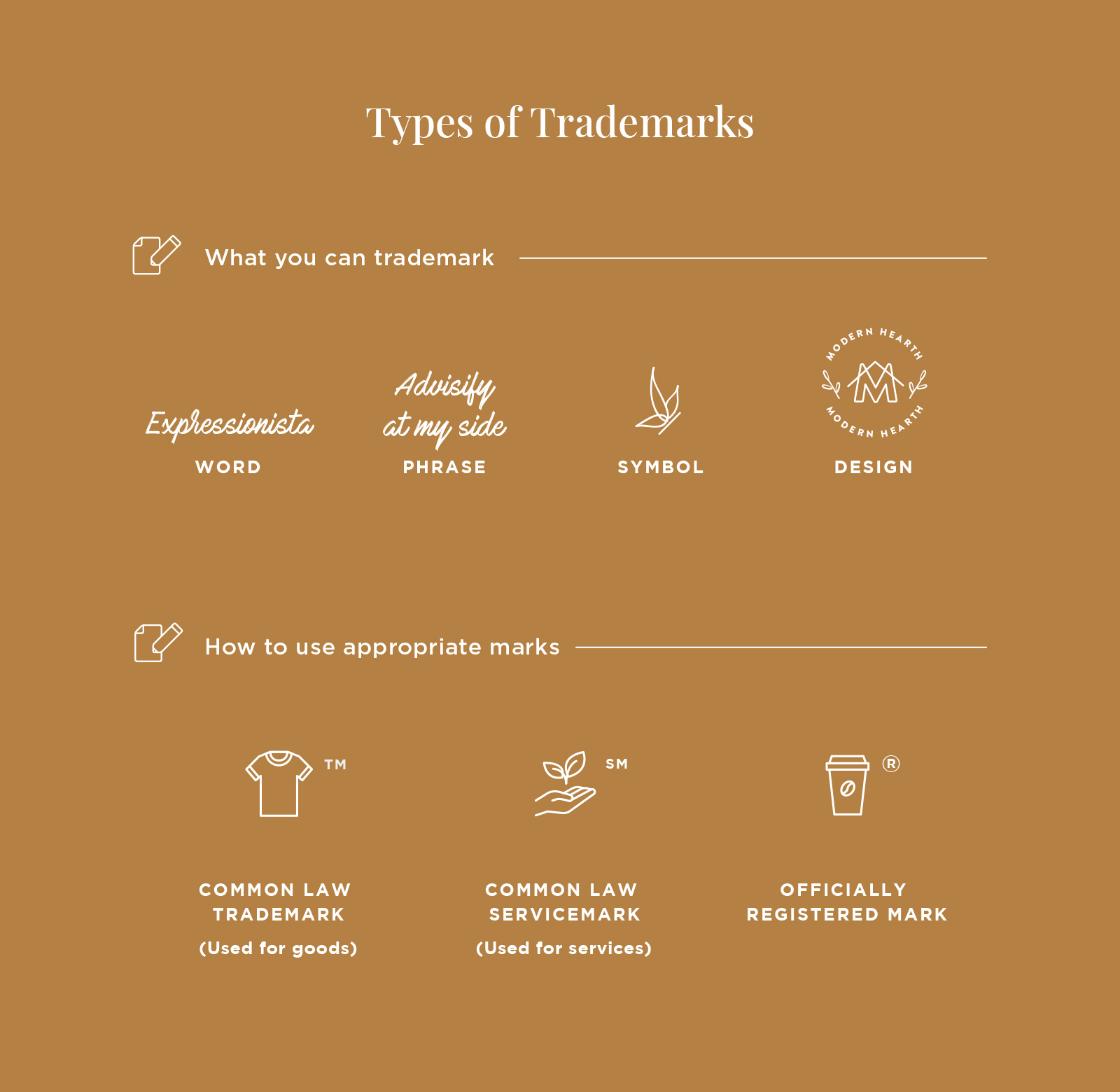
What can happen if you don’t trademark your company name?
We’ve worked with tons of clients who have run into trouble with the company naming process by choosing a name that hasn’t been properly vetted for existing trademarks or liability. We’ve also worked with clients who never trademarked a name and ran into trouble later on defending their right to a trademark, which can be a costly endeavor and a huge liability for a business.
Think about it, you invest a lot of time and resources and money into a business name: Building brand trust, developing a visual identity, creating signage and marketing materials, printing all of your physical brand assets, etc. If you don’t protect your investment by working through the trademarking process carefully and securing your mark, you are putting yourself at risk of watching that investment swirl down the drain in the future.
Real World Example: The Burger King of Mattoon, Illinois case is a perfect example of how failing to trademark your business name on a federal level can lead to a loss of potential revenue. In 1957, Gene and Betty Hoots of Mattoon officially christened their newly expanded burger business “Burger King,” at the time, the only business operating under that name. While they did file for a state trademark in 1959, the Hootses did not file a trademark application on a federal level. When a competing company in Florida began to expand into Illinois, the Hoots family decided to proceed with legal action to prevent the rival Burger King from operating in Illinois. A countersuit by the Florida company lead to an important interpretation of the Lanham Act in the 7th Circuit Court of Appeals, ruling that federal trademark takes precedence over state trademark. Because the Florida chain had filed for federal trademark, that gave them the rights to the name Burger King nationwide, except for an area within a 20 mile circumference of Mattoon, Illinois, where the Hoots family still held the right of prior use.
When you’re deciding on the name for your company it’s important to research it in the TESS database (and also the WIPO Global Brand Database), run Google searches, look up any domains that might be in use currently, take a scan across social media…And really, your best investment post-naming will be to consult a trademark attorney to help you with the application process for formally requesting the government to recognize your trademark.
2) Avoid copyright infringement with ethical, original design
Once your company name has been established, vetted, and been approved by a trademark attorney, you’ll be ready to begin crafting a visual brand identity, which typically includes a logo design, brand illustrations, patterns, fonts, and a brand color palette. This crosses into the second legal area where you’ll want to be informed and do your due diligence: Copyright.
The United States Copyright Office officially defines copyright as “Copyright is a form of protection grounded in the U.S. Constitution and granted by law for original works of authorship fixed in a tangible medium of expression. Copyright covers both published and unpublished works.” Ideas, procedures, extemporaneous speeches or improvisational performances, processes, etc. are not granted an automatic copyright. What else doesn’t fall under the copyrightable umbrella of protection? Works with “mere variations” of typography, lettering, or coloring; titles, short phrases, slogans, or names. You can get a good overview with this circular from the Copyright office.

How can I ensure my logo and brand assets are ethically sourced?
Ideally, you’ll work with a designer who will craft original work for your logo marks, brand illustrations, and icons. If they’re not creating custom work for your brand, where are the assets coming from?
Who is the original author and copyright holder of the assets created?
Has your designer obtained the appropriate permission (licensing) for your brand to use the assets?
Does your brand use stock photography or font files?
The same applies. Google is sometimes treated as a bit of a free-for-all, but an ethical designer and agency will never include assets in your brand package that aren’t either created just for you or linked to an appropriate commercial license for use. As a business owner, you have to cover your ass here. If you’re using an icon set or some other creative work that was ripped from a designer without credit or compensation, you’re opening yourself up to liability.
Real World Example: In 2002, the United States Postal Service used an image of a sculpture called “The Column,” which was created by Frank Gaylord as a commission for the Korean War Memorial in Washington, DC. The sculpture is a field of men in battle, some of them representative of soldiers Gaylord served with in World War II. Frank Gaylord sued the USPS for copyright infringement in 2006 and was eventually awarded over $600,000 in damages.
To go a step further, it’s not just about whether or not you credit the original creator or acknowledge that you don’t own the “rights” to the work. When you’re intending to use an asset such as an image or even a font file for your business, you need to know whether or not you have the appropriate license to do so.
3) Understand commercial licensing for your brand assets
There are different types of licenses, but for our purposes, we generally break them down into two main categories:
Personal Use – This means that you can download the item and use it in your personal projects however you want. You can make yourself a piece of wall art, design a family newsletter, etc. Personal Use licenses are for projects where you will not be using the work in a project for personal gain.
Commercial Use – Commercial Use licenses exist for businesses who intend to use the work in projects that are related to commerce. Think advertisements, promotional materials, on merchandise, etc. The business obviously stands to gain from the use of the work, so a commercial license is often something they must purchase from the original creator.
What’s that? You want to own the exclusive rights to your brand assets?
It’s a common misconception that you should own “exclusive copyright” to all your brand assets. Remember: A copyright is always attributed to the original creator, aka the only person who has the exclusive legal right to reproduce, publish, sell, or distribute their work. Licensing is where the original creator of a work gives a framework that details how and when you can use the work.
A clear example is font files. Your brand can use Times New Roman with the appropriate license from the creator, but you can’t restrict everyone else from using Times New Roman. Unless you hire a font designer to create a completely custom and exclusive, commercial use font for your company, one of your brand fonts will likely be licensed from a library of fonts.

Because it’s almost certain that at least one or two items within your curated branding collection will have been sourced from commercial libraries such as Shutterstock or a font library. The items will have their own copyright holder, and as such, they’ll come with a commercial license outlining the terms set forth by their creator.
It is possible, but it is likely to be prohibitively expensive, complicated, and frankly, not very practical… as all assets (like fonts) will need to be created from scratch under a work-for-hire contract. It would be like hiring an interior designer, but also having them build all the furniture.
So when the job is done and it’s time to hand over your branding goodies, anything that is created expressly for you, such as a custom logo or custom illustrations, will be your’s exclusively to use whenever and however you like. Anything sourced for you, like a commercial font file or stock photography, will come with the appropriate license from the original content creator.
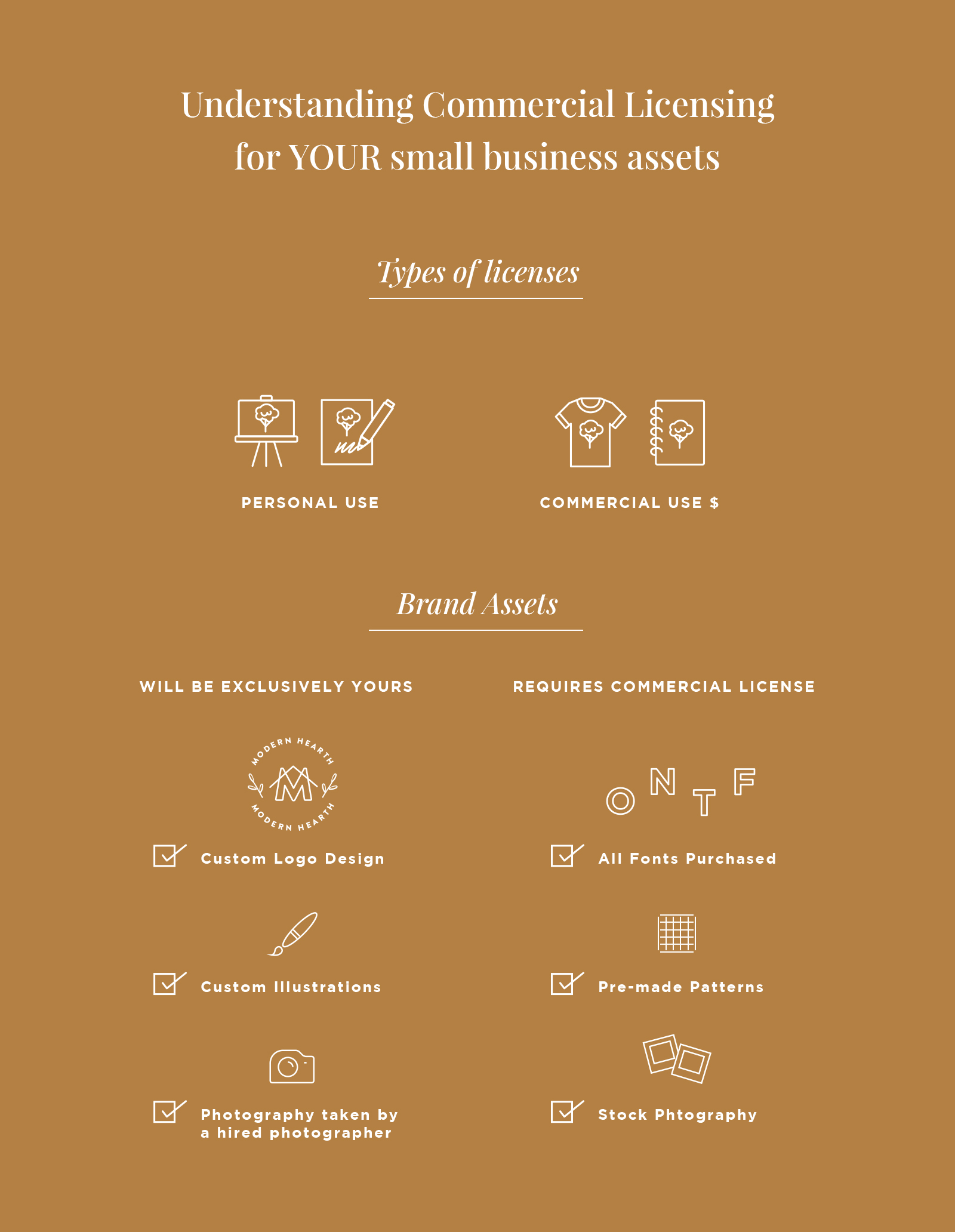
Disclaimer:
Trademarks, copyrights, and licensing…Oh my! Look, intellectual property law is definitely tricky, and the information (and misinformation) out there can be overwhelming. We’re not lawyers, and while we work with these aspects of the law every day, the very best investment you’ll make when it comes to questions of intellectual property will be a consultation with an attorney who specializes in this area. After every naming project, we recommend our clients to partner up with a trademark attorney to begin the filing process. We often refer them to one of our trademark resources like Matt Chambers of Spengler & Agans Law, LLC. in Charlotte, North Carolina. Here’s what he has to say about the benefits of having an attorney to run your questions by:
Intellectual property covers a company’s most important assets. One simple misstep, even done with the right intentions, can lead to costly mistakes. That licensing agreement found online may be written for the benefit of other party rather than you. That trademark application may be rejected for countless reasons, limiting future options for your brand. That video for your website from an overseas video editor or freelance website may get you sued for copyright infringement. Saving money on an attorney up front can cost a lot of money later, and even worse, require reworking a company’s entire brand. A qualified intellectual property attorney can help you navigate these potential problems and avoid the headache later.
For trademarks, it’s important to conduct a search of the USPTO database for similar trademarks before applying. If there are similar marks that have already been registered, an attorney can tweak or split up the marks and logos into multiple applications to improve the chances of approval. Examining attorneys will review the application, and follow-up with deficiencies in the application. It’s not uncommon to send in a new specimen, addendums, and even case law to convince the USPTO examining attorney to see things your way. The whole process can take six months to one year, so it is valuable to get it right early. A rejection by the USPTO leads to trademark abandonment after a certain period of time and creates an uphill climb to revive or refile.
Having an attorney review licensing agreements and copyright procedures ahead of time can also save you time, energy, and money in the long run. Agreements you find online can be a good start, but they are usually written for the benefit of one party – that is, a sample agreement you find online will often be written in favor of the licensee or the licensor. Whether it’s a licensing agreement, a work made for hire agreement, or a copyright assignment, the wrong wording can cost tens of thousands of dollars. That’s not to say that you need to pay an attorney every time you work with copyrights. For example, a good intellectual property attorney will educate you and cover basic guidelines for how to maximize the use of IP in your business and where you can appropriately source the works of others without being hit with a costly lawsuit.

The bottom line? Do your due diligence when it comes trademarking and sourcing commercial-use assets for your business. A little planning and research on the front-end can save you a big headache, and possibly a lawsuit, on the back-end.
Have you dealt with any trademark troubles or had difficulty figuring out the best license to purchase for your company when it comes to artwork? Tell us in the comments below!


